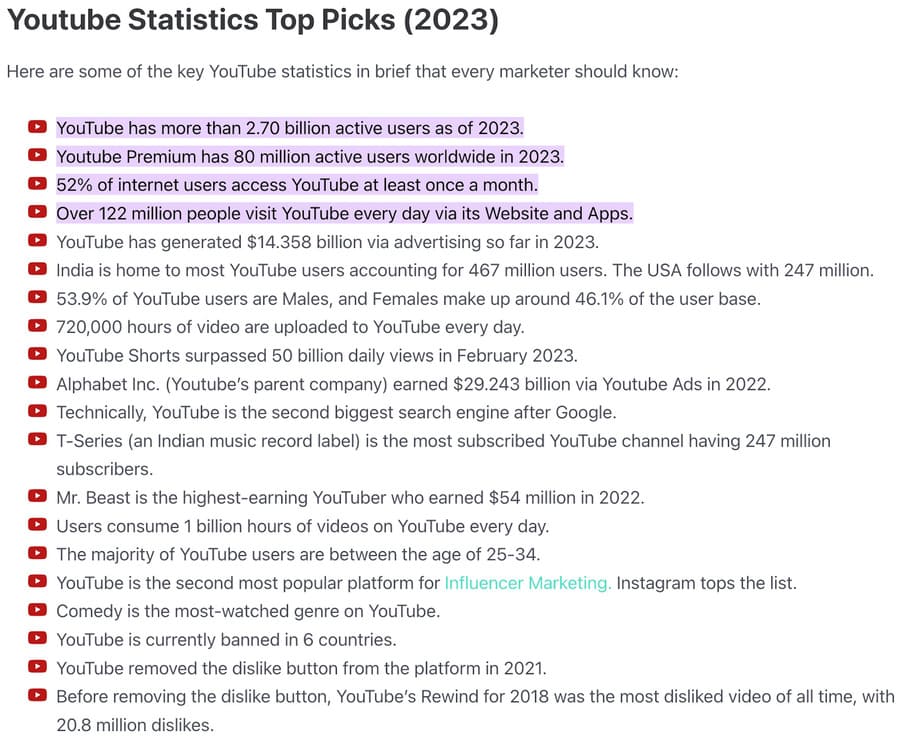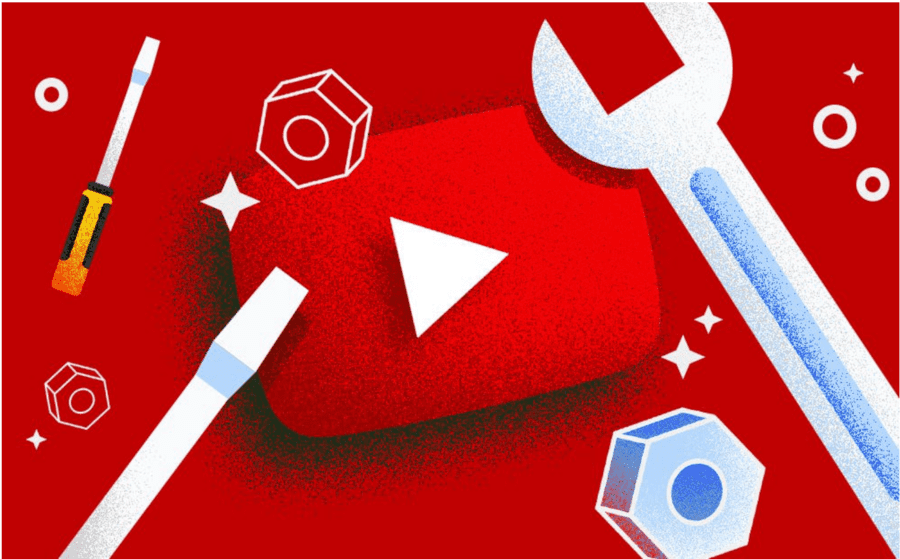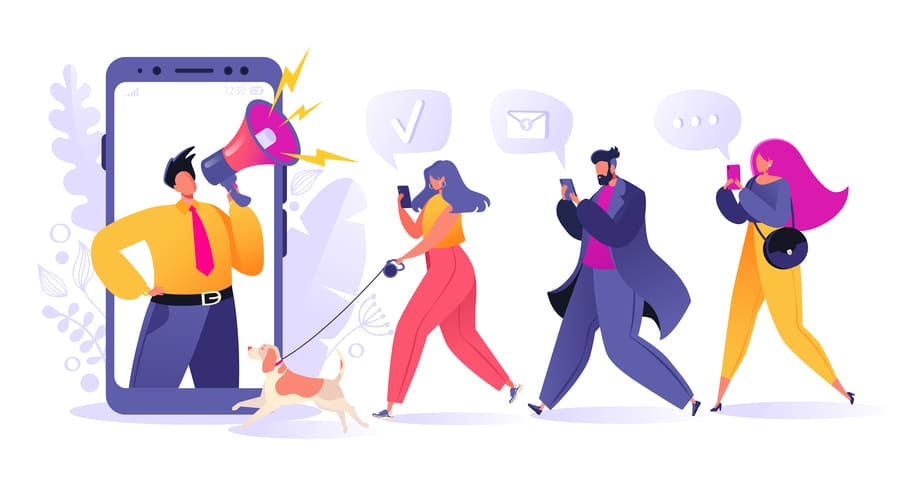Ready to get started with YouTube marketing but don’t know where to begin?
Tons of social media competition and short attention spans make standing out on the world’s second-largest search engine seem unattainable.
But for social media mavens, content marketing gurus, and online business owners like you, mastering YouTube can be your golden ticket.
Whether you’re a seasoned marketer or a business newbie, this short, sweet, and complete guide will help you create a successful YouTube marketing campaign that gets your YouTube channel (and business) noticed.
Ready?
Let’s do this!
What is YouTube Marketing?
YouTube Marketing is the practice of using a dynamic set of tactics on your YouTube channel to boost your products, services, or brand via the power of the YouTube platform.
An increasingly integral part of a broader social media marketing strategy, targeted YouTube content is key to building brand awareness.
Far more than just making random video uploads, a YouTube marketing strategy employs research, social media insights, and data to help make decisions about every detail of a YouTube campaign.
Think on-brand channel art, SEO-savvy video descriptions, intentional partnerships with YouTube influencers, and smart YouTube ad placements.
The goal?
Grab attention, spark engagement, and lead viewers to take action — like clicking to your site or making a purchase.
It’s blending creativity with data insights to help you become a YouTube rockstar!
Do You Really Need a YouTube Channel?
Spoiler alert…
YES.
If you have a business in 2023, a social media presence is no longer an option. It’s a necessity.
YouTube is no exception. Boasting over 2.7 billion logged-in monthly users, it’s a dynamic social media platform that spans demographics and geographies. Multitudes of YouTube viewers are out there looking for exactly whatever it is you’re selling.
And if growth and greater brand awareness are on your agenda, YouTube is where you need to be to help them find it.
Nearly every statistic underscores a truth: a thriving YouTube channel is a goldmine. If you don’t have a YouTube channel, you’re sending your customers to competitors who do.

This is How to Create a Kick-ass YouTube Marketing Strategy in 13 Steps
If you want to harness YouTube’s gargantuan potential, you won’t do it with random, inconsistent uploads to your YouTube channel.
You need a strategy — a roadmap to social media engagement and conversion.
Here’s how to craft yours:
1. Start With Your Target Audience

Want to know the insider secret to YouTube channel success?
Hint: Just like any other digital marketing strategy or social media campaign, it all begins with understanding who you’re trying to reach.
These are the folks who’ll eagerly devour your video content, nod in agreement, hit ‘like,’ and wait with bated breath for your next upload.
So, dive deep and analysis who your target audience is.
Are they corporate mavens? Female biohackers? Social media marketers? Quirky DIY enthusiasts? Passionate plant parents?
By defining their interests, age range, habits, and pain points, you tailor your video content to resonate, making your videos feel like they were made just for them.
Because, well, they were.
By understanding who you serve, you can tailor YouTube video content that resonates, engages, and converts.
So, before you dream of social media fame and viral videos, lock in on your target audience. It’s the cornerstone of your YouTube castle!
2. Create Engaging YouTube Video Content. Consistently.

The heart of any YouTube strategy? Targeted video content.
Once you understand your target audience, identifying topics for your YouTube video is the easy part.
You’ll also need a compelling story, an intro that hooks, an on-brand background, great sound, and video quality. A catchy voiceover or soundtrack can also elevate your video’s engagement factor.
And consistency? It’s king.
Regular uploads create a rhythm, building anticipation and trust among your YouTube subscribers. Think of it as your favourite TV show — if it aired sporadically, you’d lose interest.
The same goes for your YouTube channel.
Time spent learning about how to make successful YouTube videos is an investment in your future success.
Engage, captivate, repeat — that’s your mantra!
3. Align Your Brand Elements
Just like any social media strategy, building your brand identity is a key component of an air-tight YouTube marketing plan. So it’s important to align your brand elements across your channel.
This goes far beyond your video content.
Think colours, fonts, intros, tone, vibe, background music, and anything else that conveys the personality of your channel.
Every banner, playlist, and video thumbnail on your YouTube channel should scream your brand.
Imagine throwing a themed bash at your place. Would you slap on Star Wars décor and expect folks to feel the 1920s Gatsby vibe? Heck, no!
The channel icon? That’s your front door.
And oh, that channel description? Think of it as the catchy invite getting folks hyped up for the festivities.
When brand elements align, the right visitors can’t help but resonate more deeply with your content.
And that’s when YouTube visitors become YouTube subscribers.
4. Utilize YouTube Tools

YouTube wants you to be awesome at YouTube marketing.
In fact, YouTube’s magic treasure chest of tools can vastly enhance your video content marketing.
From in-depth analytics to subtitle generators, the platform offers a myriad of easy-to-use options to amplify your content’s reach and appeal, all without the expense of a digital marketing agency.
In addition to YouTube Studio, various third-party apps can bring the power of a small Hollywood studio and mini-marketing agency to your video creation.
A cornucopia of tools exists to help you make amazing videos easily.
Learn to use them!
5. Keep YouTube SEO in Mind
YouTube SEO amplifies reach, ensuring that your meticulously crafted content doesn’t get lost in the digital abyss.
Although your content should always be audience-first, integrating SEO strategies can help you get discovered!
Suppose your channel covers Canadian hiking. You can make stunning videos of Canada’s top hikes, but without using the right keywords, your target audience won’t find you.
Pave a path to your channel with relevant keywords in video titles, descriptions, taglines, and scripts.
Learning YouTube SEO basics can help you stand out, and your future fans will thank you for helping them find you!
6. Optimize For Voice Search

When it comes to any kind of content marketing, we can’t talk about SEO without also discussing voice search.
With the rise of Alexa, Siri, Google Assistant, and more on the way, voice search isn’t the future, it’s the “now.” In fact, nearly 50% of adults report they use voice search daily.
Why is this important?
Well, there are differences between how people search using text vs. voice.
When searching with voice, most people use natural language, which means long-tail keywords and questions.
Makes sense, right?
On the other hand, text search is short, and search engines provide more options for users to choose from.
This difference has ginormous implications for you and how you implement SEO on your YouTube channel.
So, pack in those long-tail keywords, construct your content like it’s a Q&A session, and keep your scripts sounding natural and chatty.
7. Refine Your Video Thumbnails & Descriptions
First impressions matter.
Your video thumbnails and descriptions are the storefronts of your channel, and their appeal determines whether a viewer strolls by or steps in.
When you create a YouTube thumbnail, make sure it’s vibrant, clear, and compelling.
Pair it with a video description that is catchy, informative, and packed with SEO-friendly keywords that guide search engines and viewers alike to your channel.
This isn’t mere beautification; it’s a strategic move that can dramatically boost your click-through rates, video views, subscribers, sales, income, and more.
8. Share Stories, YouTube Style

Stories are relatable, emotional, and memorable. They connect us as humans.
To tap into this, craft your content as narratives. Instead of just listing features of a product, tell the story of how it solved a real problem.
Use behind-the-scenes videos to share your company’s journey, personal anecdotes to foster connection, or customer testimonials as authentic, captivating tales.
By weaving your content into stories, you’re inviting viewers to gather around your digital campfire, sparking not just video views, but engagement and trust.
Stories build connections, and sharing yours can forge deeper viewer relationships.
Use YouTube’s story feature to showcase short, engaging snippets, offering a personal touch to your brand narrative.
Even a relatable YouTube short could result in new subscribers!
9. Harness Cross-Promotion
Think of cross-promotion as the ‘you scratch my back, I’ll scratch yours’ of YouTube marketing.
In a space as vast as YouTube, your solo voyage to stardom could be a slow sail.
Why go it alone? Partner up!
Find creators or brands that align with your values and audience but aren’t direct competitors.
Share their content on your channels and let them do the same. Collaborate on a video project or share a video ad that appeals to both your viewers.
It’s a win-win; you gain exposure to their audience and vice versa.
Imagine this as trading golden tickets with fellow adventurers; together, you’re unlocking broader vistas of potential viewership.
10. Consider Influencer Marketing

Partnering with an influencer is like adding a dash of champagne to your digital bash.
The secret of influencer marketing is out. These social superstars come with their own eager audience, and inviting one to collaborate on your content instantly boosts brand credibility.
Partner with someone who resonates with your brand’s values and message, whose values align with yours, and who speaks to an audience that you want to connect with.
Whether it’s through a candid conversation, a shared project, or a product review, this partnership is your introduction to a new sphere of potential customers, many of whom could be the next members of your tribe.
11. Make the Most of YouTube Ads
Ready to supercharge your YouTube presence?
Say hello to YouTube Ads.
First up, define your goals.
Want eyeballs on your brand or clicks to your site? Your goal shapes your strategy.
Next, target like a pro.
YouTube lets you aim your ads at specific ages, locations, interests, and more.
Budget-wise, start small. Test, learn, then adapt. A YouTube ad is less expensive than a Google ad, and overall, a better bang for your buck.
Crafting the YouTube ad is an art in itself — make it engaging, authentic, and, crucially, valuable to the viewer.
End with a strong call to action; tell viewers exactly what you want them to do next.
And here’s the golden rule: keep an eye on YouTube analytics. The numbers will tell you what’s working and what needs a tune-up.
12. Monitor Your YouTube Channel Performance
You’ve honed your YouTube content and advertising and maybe even dipped your toe into YouTube Live.
Next is YouTube Analytics. They’re your essential tools and guides, directing your path.
Make delving into YouTube Analytics a regular part of your process; it’s a rich source of data that shows which videos excel and which ones falter.
Views, watch time, audience engagement, and click-through rates — these are your benchmarks.
If one video gained traction, analyse it. Was its success due to the video title, thumbnail, or content?
And if another video didn’t quite hit the mark, adjust your approach. Refine your YouTube video marketing strategy and shift your focus to better results.
Staying attentive to your data and using it to adapt and refine your strategy is key to achieving greater success.
13. Track Your Competition

Standing out on YouTube means knowing what your high-ranking competitors are up to.
Competitor research is an underutilized YouTube marketing tool.
So, start by identifying your key competitors — those in your niche, with similar audience size or content style.
Now, be a YouTube detective.
Check their video titles and descriptions. What keywords are they targeting? Peek at their thumbnails; are they vibrant and eye-catching?
Dive into their posting schedule; when and how often are they uploading? Engage with their content; what kind of calls-to-action are they using? Do they utilize influencer marketing?
Don’t forget the comments section; it’s a goldmine for audience sentiment.
Now, here’s another opportunity to use the magic sauce: YouTube Analytics.
While you can’t access a competitor’s private data, tools like SocialBlade or TubeBuddy offer valuable insights. Track their subscriber growth, view counts, and engagement rates.
It’s not about copying, it’s about learning and strategizing. How can you differentiate? Use that intel to improve your own strategy.
Now Go Rock Your YouTube Marketing Strategy
Ready to turn your vision into viewers? It’s time to step into the spotlight.
Your stage is set, your audience awaits, and now, you have a 13-step script in hand.
Cheers to your future YouTube stardom!
By Loree Hollander
Loree Hollander is a content creator, editor, and SEO strategist who specializes in psychology, health, wellness, and the intersection of science and spirituality. When not writing, reading, or traveling, she spends time with her husband in the woods and on the water in the beautiful Pacific Northwest.
















